Qi Zhu
Northwestern University
Rethinking Expert Trajectory Utilization in LLM Post-training
Dec 12, 2025Abstract:While effective post-training integrates Supervised Fine-Tuning (SFT) and Reinforcement Learning (RL), the optimal mechanism for utilizing expert trajectories remains unresolved. We propose the Plasticity-Ceiling Framework to theoretically ground this landscape, decomposing performance into foundational SFT performance and the subsequent RL plasticity. Through extensive benchmarking, we establish the Sequential SFT-then-RL pipeline as the superior standard, overcoming the stability deficits of synchronized approaches. Furthermore, we derive precise scaling guidelines: (1) Transitioning to RL at the SFT Stable or Mild Overfitting Sub-phase maximizes the final ceiling by securing foundational SFT performance without compromising RL plasticity; (2) Refuting ``Less is More'' in the context of SFT-then-RL scaling, we demonstrate that Data Scale determines the primary post-training potential, while Trajectory Difficulty acts as a performance multiplier; and (3) Identifying that the Minimum SFT Validation Loss serves as a robust indicator for selecting the expert trajectories that maximize the final performance ceiling. Our findings provide actionable guidelines for maximizing the value extracted from expert trajectories.
DeepPHY: Benchmarking Agentic VLMs on Physical Reasoning
Aug 07, 2025Abstract:Although Vision Language Models (VLMs) exhibit strong perceptual abilities and impressive visual reasoning, they struggle with attention to detail and precise action planning in complex, dynamic environments, leading to subpar performance. Real-world tasks typically require complex interactions, advanced spatial reasoning, long-term planning, and continuous strategy refinement, usually necessitating understanding the physics rules of the target scenario. However, evaluating these capabilities in real-world scenarios is often prohibitively expensive. To bridge this gap, we introduce DeepPHY, a novel benchmark framework designed to systematically evaluate VLMs' understanding and reasoning about fundamental physical principles through a series of challenging simulated environments. DeepPHY integrates multiple physical reasoning environments of varying difficulty levels and incorporates fine-grained evaluation metrics. Our evaluation finds that even state-of-the-art VLMs struggle to translate descriptive physical knowledge into precise, predictive control.
HeLo: Heterogeneous Multi-Modal Fusion with Label Correlation for Emotion Distribution Learning
Jul 09, 2025Abstract:Multi-modal emotion recognition has garnered increasing attention as it plays a significant role in human-computer interaction (HCI) in recent years. Since different discrete emotions may exist at the same time, compared with single-class emotion recognition, emotion distribution learning (EDL) that identifies a mixture of basic emotions has gradually emerged as a trend. However, existing EDL methods face challenges in mining the heterogeneity among multiple modalities. Besides, rich semantic correlations across arbitrary basic emotions are not fully exploited. In this paper, we propose a multi-modal emotion distribution learning framework, named HeLo, aimed at fully exploring the heterogeneity and complementary information in multi-modal emotional data and label correlation within mixed basic emotions. Specifically, we first adopt cross-attention to effectively fuse the physiological data. Then, an optimal transport (OT)-based heterogeneity mining module is devised to mine the interaction and heterogeneity between the physiological and behavioral representations. To facilitate label correlation learning, we introduce a learnable label embedding optimized by correlation matrix alignment. Finally, the learnable label embeddings and label correlation matrices are integrated with the multi-modal representations through a novel label correlation-driven cross-attention mechanism for accurate emotion distribution learning. Experimental results on two publicly available datasets demonstrate the superiority of our proposed method in emotion distribution learning.
MorphSAM: Learning the Morphological Prompts from Atlases for Spine Image Segmentation
Jun 16, 2025Abstract:Spine image segmentation is crucial for clinical diagnosis and treatment of spine diseases. The complex structure of the spine and the high morphological similarity between individual vertebrae and adjacent intervertebral discs make accurate spine segmentation a challenging task. Although the Segment Anything Model (SAM) has been developed, it still struggles to effectively capture and utilize morphological information, limiting its ability to enhance spine image segmentation performance. To address these challenges, in this paper, we propose a MorphSAM that explicitly learns morphological information from atlases, thereby strengthening the spine image segmentation performance of SAM. Specifically, the MorphSAM includes two fully automatic prompt learning networks, 1) an anatomical prompt learning network that directly learns morphological information from anatomical atlases, and 2) a semantic prompt learning network that derives morphological information from text descriptions converted from the atlases. Then, the two learned morphological prompts are fed into the SAM model to boost the segmentation performance. We validate our MorphSAM on two spine image segmentation tasks, including a spine anatomical structure segmentation task with CT images and a lumbosacral plexus segmentation task with MR images. Experimental results demonstrate that our MorphSAM achieves superior segmentation performance when compared to the state-of-the-art methods.
ClusterUCB: Efficient Gradient-Based Data Selection for Targeted Fine-Tuning of LLMs
Jun 12, 2025Abstract:Gradient-based data influence approximation has been leveraged to select useful data samples in the supervised fine-tuning of large language models. However, the computation of gradients throughout the fine-tuning process requires too many resources to be feasible in practice. In this paper, we propose an efficient gradient-based data selection framework with clustering and a modified Upper Confidence Bound (UCB) algorithm. Based on the intuition that data samples with similar gradient features will have similar influences, we first perform clustering on the training data pool. Then, we frame the inter-cluster data selection as a constrained computing budget allocation problem and consider it a multi-armed bandit problem. A modified UCB algorithm is leveraged to solve this problem. Specifically, during the iterative sampling process, historical data influence information is recorded to directly estimate the distributions of each cluster, and a cold start is adopted to balance exploration and exploitation. Experimental results on various benchmarks show that our proposed framework, ClusterUCB, can achieve comparable results to the original gradient-based data selection methods while greatly reducing computing consumption.
Self-Error-Instruct: Generalizing from Errors for LLMs Mathematical Reasoning
May 28, 2025
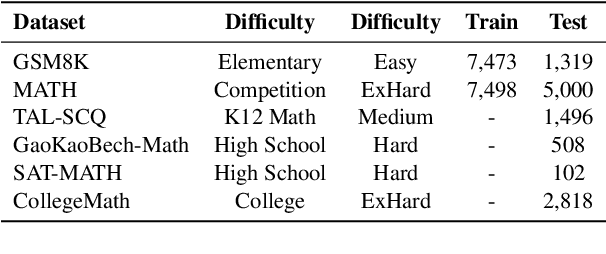

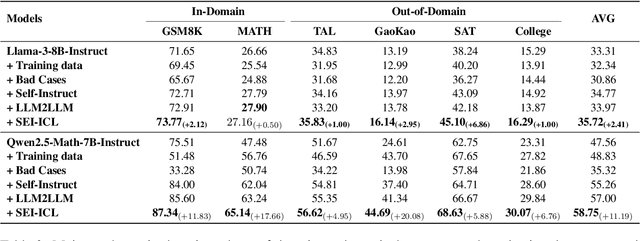
Abstract:Although large language models demonstrate strong performance across various domains, they still struggle with numerous bad cases in mathematical reasoning. Previous approaches to learning from errors synthesize training data by solely extrapolating from isolated bad cases, thereby failing to generalize the extensive patterns inherent within these cases. This paper presents Self-Error-Instruct (SEI), a framework that addresses these model weaknesses and synthesizes more generalized targeted training data. Specifically, we explore a target model on two mathematical datasets, GSM8K and MATH, to pinpoint bad cases. Then, we generate error keyphrases for these cases based on the instructor model's (GPT-4o) analysis and identify error types by clustering these keyphrases. Next, we sample a few bad cases during each generation for each identified error type and input them into the instructor model, which synthesizes additional training data using a self-instruct approach. This new data is refined through a one-shot learning process to ensure that only the most effective examples are kept. Finally, we use these curated data to fine-tune the target model, iteratively repeating the process to enhance performance. We apply our framework to various models and observe improvements in their reasoning abilities across both in-domain and out-of-domain mathematics datasets. These results demonstrate the effectiveness of self-error instruction in improving LLMs' mathematical reasoning through error generalization.
Pitfalls of Rule- and Model-based Verifiers -- A Case Study on Mathematical Reasoning
May 28, 2025Abstract:Trustworthy verifiers are essential for the success of reinforcement learning with verifiable reward (RLVR), which is the core methodology behind various large reasoning models such as DeepSeek-R1. In complex domains like mathematical reasoning, rule-based verifiers have been widely adopted in previous works to train strong reasoning models. However, the reliability of these verifiers and their impact on the RL training process remain poorly understood. In this work, we take mathematical reasoning as a case study and conduct a comprehensive analysis of various verifiers in both static evaluation and RL training scenarios. First, we find that current open-source rule-based verifiers often fail to recognize equivalent answers presented in different formats across multiple commonly used mathematical datasets, resulting in non-negligible false negative rates. This limitation adversely affects RL training performance and becomes more pronounced as the policy model gets stronger. Subsequently, we investigate model-based verifiers as a potential solution to address these limitations. While the static evaluation shows that model-based verifiers achieve significantly higher verification accuracy, further analysis and RL training results imply that they are highly susceptible to hacking, where they misclassify certain patterns in responses as correct (i.e., false positives). This vulnerability is exploited during policy model optimization, leading to artificially inflated rewards. Our findings underscore the unique risks inherent to both rule-based and model-based verifiers, aiming to offer valuable insights to develop more robust reward systems in reinforcement learning.
How Should We Enhance the Safety of Large Reasoning Models: An Empirical Study
May 21, 2025Abstract:Large Reasoning Models (LRMs) have achieved remarkable success on reasoning-intensive tasks such as mathematics and programming. However, their enhanced reasoning capabilities do not necessarily translate to improved safety performance-and in some cases, may even degrade it. This raises an important research question: how can we enhance the safety of LRMs? In this paper, we present a comprehensive empirical study on how to enhance the safety of LRMs through Supervised Fine-Tuning (SFT). Our investigation begins with an unexpected observation: directly distilling safe responses from DeepSeek-R1 fails to significantly enhance safety. We analyze this phenomenon and identify three key failure patterns that contribute to it. We then demonstrate that explicitly addressing these issues during the data distillation process can lead to substantial safety improvements. Next, we explore whether a long and complex reasoning process is necessary for achieving safety. Interestingly, we find that simply using short or template-based reasoning process can attain comparable safety performance-and are significantly easier for models to learn than more intricate reasoning chains. These findings prompt a deeper reflection on the role of reasoning in ensuring safety. Finally, we find that mixing math reasoning data during safety fine-tuning is helpful to balance safety and over-refusal. Overall, we hope our empirical study could provide a more holistic picture on enhancing the safety of LRMs. The code and data used in our experiments are released in https://github.com/thu-coai/LRM-Safety-Study.
ViEEG: Hierarchical Neural Coding with Cross-Modal Progressive Enhancement for EEG-Based Visual Decoding
May 18, 2025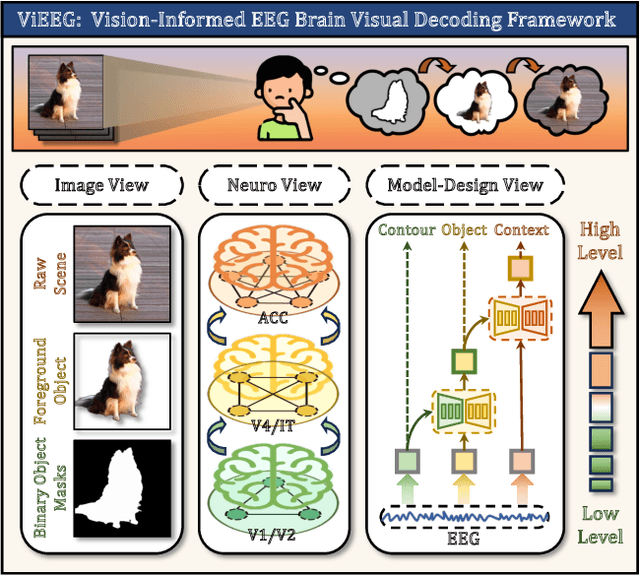
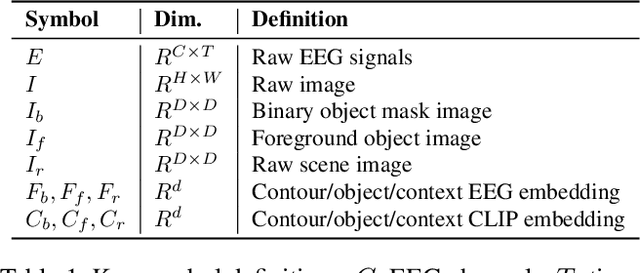

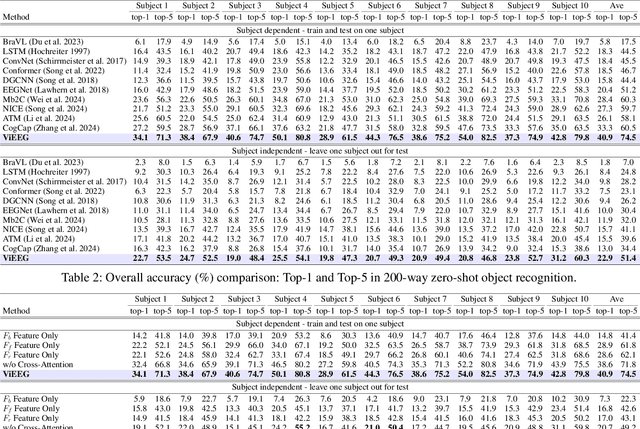
Abstract:Understanding and decoding brain activity into visual representations is a fundamental challenge at the intersection of neuroscience and artificial intelligence. While EEG-based visual decoding has shown promise due to its non-invasive, low-cost nature and millisecond-level temporal resolution, existing methods are limited by their reliance on flat neural representations that overlook the brain's inherent visual hierarchy. In this paper, we introduce ViEEG, a biologically inspired hierarchical EEG decoding framework that aligns with the Hubel-Wiesel theory of visual processing. ViEEG decomposes each visual stimulus into three biologically aligned components-contour, foreground object, and contextual scene-serving as anchors for a three-stream EEG encoder. These EEG features are progressively integrated via cross-attention routing, simulating cortical information flow from V1 to IT to the association cortex. We further adopt hierarchical contrastive learning to align EEG representations with CLIP embeddings, enabling zero-shot object recognition. Extensive experiments on the THINGS-EEG dataset demonstrate that ViEEG achieves state-of-the-art performance, with 40.9% Top-1 accuracy in subject-dependent and 22.9% Top-1 accuracy in cross-subject settings, surpassing existing methods by over 45%. Our framework not only advances the performance frontier but also sets a new paradigm for biologically grounded brain decoding in AI.
Directly Forecasting Belief for Reinforcement Learning with Delays
May 01, 2025Abstract:Reinforcement learning (RL) with delays is challenging as sensory perceptions lag behind the actual events: the RL agent needs to estimate the real state of its environment based on past observations. State-of-the-art (SOTA) methods typically employ recursive, step-by-step forecasting of states. This can cause the accumulation of compounding errors. To tackle this problem, our novel belief estimation method, named Directly Forecasting Belief Transformer (DFBT), directly forecasts states from observations without incrementally estimating intermediate states step-by-step. We theoretically demonstrate that DFBT greatly reduces compounding errors of existing recursively forecasting methods, yielding stronger performance guarantees. In experiments with D4RL offline datasets, DFBT reduces compounding errors with remarkable prediction accuracy. DFBT's capability to forecast state sequences also facilitates multi-step bootstrapping, thus greatly improving learning efficiency. On the MuJoCo benchmark, our DFBT-based method substantially outperforms SOTA baselines.
 Add to Chrome
Add to Chrome Add to Firefox
Add to Firefox Add to Edge
Add to Edge